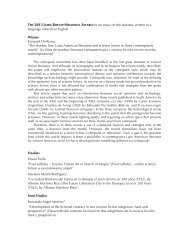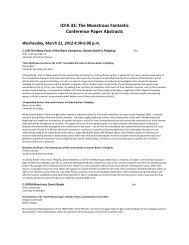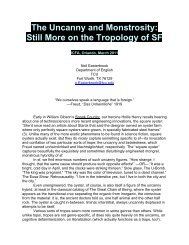The Monstrous Fantastic Conference Paper Abstracts - International ...
The Monstrous Fantastic Conference Paper Abstracts - International ...
The Monstrous Fantastic Conference Paper Abstracts - International ...
You also want an ePaper? Increase the reach of your titles
YUMPU automatically turns print PDFs into web optimized ePapers that Google loves.
<strong>Fantastic</strong> Romantics: Romantics as Characters in <strong>Fantastic</strong> Fiction: Edgar Allan PoeTerry M. WeynaIndependent ScholarIn my previous discussions of Romantics in fantastic literature, I focused on Keats as an avatar of the fantastic (ICFA 2000); Byron’s use as adashing figure of dark romance and mystery (ICFA 2001); and Shelly’s use as a mythical figure himself, his own Prometheus (ICFA 2003). Thisyear, I will focus on Edgar Allan Poe, my first venture into examining the American Romantics. Poe has been and continues to be widely used asa character in fantastic fiction, including “In the Sunken Museum” from Gregory Frost’s Attack of the Jazz Giants (Golden Gryphon, 2005) (inwhich Poe loses his mind quite thoroughly in the course of a scientific experiment gone awry); Rudy Rucker’s <strong>The</strong> Hollow Earth (William Morrow& Co., Inc., 1990) (in which Poe undertakes an expedition to the South Pole); Manley Wade Wellman’s “When It Was Moonlight” (1940) (inwhich Poe uncovers a vampire who arose from a premature burial and is defeated by burial in a wall); Harold Schechter’s <strong>The</strong> Hum Bug (PocketBooks, 2001) and Nevermore (Pocket Books, 1999) (in which Poe acts as a detective to solve horrific crimes), and many others. Despite hisreputation as a master of horror, Poe is used most often as a figure in a scientific tale of one sort or another, always marrying the imaginationto the empirical world. Why this man? What is it about Poe and his legacy that is so attractive to the modern writer of the fantastic? Morebroadly – and the question I address in my larger project, of which this paper on Poe is but one chapter – why are Romantics such popularcharacters in fantastic fiction? What is it about these sensualists, these literary theorists, these naturalists and philosophers, theseexperimenters with form and masters of language, that so entrances contemporary writers of speculative fiction? In Hyperion (1989) and <strong>The</strong>Fall of Hyperion (1990), Dan Simmons creates a new John Keats, embodied in a cybrid; and a poet, Martin Silenus, is in the process of rewritingKeats’s poetry. In “Sister Emily’s Lightship” (1998), Jane Yolen imagines Emily Dickinson meeting aliens while on her nightly stroll with her dog.In Tom Holland’s Lord of the Dead (1995), Lord Byron’s sensuality and poetic nature lead him into the arms of a beautiful vampire, making himone of the most formidable of the undead. In John Kessel’s “Herman Melville: Space Opera Virtuoso” (1980), Melville becomes a “bright youngstar in the SF firmament,” transforming the genre from Hugo Gernsback’s original ambitions for the genre into the wildly imaginative genre weenjoy today. In R.F. Nelson’s Blake’s Progress (1975), Blake visits with Cleopatra, Ezekiel, Churchill and JFK without leaving his easy chair. InPaul West’s Lord Byron’s Doctor (1989), Polidori watches Byron, Shelley and Mary Shelley sample every form of debauchery and dabble insatanism and the occult. In Tim Powers’s <strong>The</strong> Stress of Her Regard (1989), Shelley and Keats struggle with forces beyond their comprehension –but not beyond their imaginations. Why these poets and writers? Why not purely fictional characters? One explanation is that these Romanticnovelists and poets possessed a “firm belief in the autonomy of a poet’s imagination” (Bloom, 1). <strong>The</strong>y sought a life of the mind, a life lived inletters, a life in which poetry was more important than the day-to-day tangibility of life. <strong>The</strong> American Romantics created new modes ofstorytelling to match the newness of their nation (Poe the detective story, for instance; Melville and Hawthorne, the novel itself). Each of themcreated a body of remarkable work filled with extraordinary creatures not of this world – their own fantastic fiction, from Keats’s Lamia to Poe’sM. Valdemar to Melville’s white whale to Shelley’s Prometheus. Yet each was also tied to the world, to reason, to science, to nature, and feltthat their writing made the real more real. As Shelley proclaims in “A Defence of Poetry” (1821/1840): “Reason is the enumeration ofquantities already known; imagination is the perception of the value of those quantities, both separately and as a whole. Reason respects thedifferences, and imagination the similitudes of things. Reason is to Imagination as the instrument to the agent, as the body to the spirit, as theshadow to the substance….A poem is the very image of life expressed in its eternal truth” (339, 342). Contemporary writers of the fantasticsimilarly use the Romantics as characters in their fiction in order to integrate reason with imagination. Poe added code-breaking andmathematical deduction to a pirate tale in “<strong>The</strong> Gold-Bug,” pondered the modern phenomenon of hypnotism in “<strong>The</strong> Facts in the Case of M.Valdemar,” and studied crime-solving to create the modern detective story in such tales as “<strong>The</strong> Murders in the Rue Morgue.” With these tales,Poe created the modern short story and gave Romantic poetry its darker, Gothic aspect. Thus, I will examine why Poe is so attractive as asubject by exploring the way in which contemporary authors have used Poe’s manipulation of science, nature and language to their advantage.In a wider sense, I will be examining how fantastic fiction is itself a highly Romantic endeavor.<strong>The</strong> <strong>Monstrous</strong> and the <strong>Fantastic</strong> in the Short Stories of Edgar Allan Poe and the Paintings by Antoine WiertzJan Vander LaenenIndependent Scholar<strong>The</strong> Belgian painter and sculptor Antoine Wiertz (1806-1865) can be labeled as “monstrous” in more than one respect. Not only has he literallyreproduced “monsters,” such as Cyclops and witches and the political “monster” Napoleon Bonaparte in a sea of flames in hell; he has, onseveral occasions, also taken inspiration for the paintings on his canvasses from the more inhuman aspects of society at that time and mankindin general. Worthy of mention in this regard are “Hunger, Madness, Crime,” a woman who cuts off her baby¹s leg and deposits it in the cookingpot because she cannot pay her taxes, the triptych “Visions of a Severed Head”, a lampoon against the guillotine, “<strong>The</strong> Burnt Infant,” a motherwho finds her baby¹s cradle in flames by the fireplace when returning home because she cannot afford a nanny, and the frightening image of“<strong>The</strong> Suicide,” an indictment of Marxist materialism and atheism. Strangely enough, Wiertz is dismissed as a charlatan by Charles Baudelaire inhis “La Belgique deshabillée,” whereas the French poet is an absolute admirer of Wiertz’s contemporary, Edgar Allan Poe: he has translatedseveral of Poe¹s short stories into French, compiling them as, among other things, “histoires extraordinaires,” which is extraordinary in thesense that they are, through their monstrousness, far removed from the ordinary and everyday life just take the orangutan in “<strong>The</strong> Murders inthe Rue Morgue” or the madman in “<strong>The</strong> Tell-Tale Heart.” <strong>The</strong> paper entitled “<strong>The</strong> monstrous and the fantastic in the short stories of EdgarAllan Poe and the paintings by Antoine Wiertz” draws parallels between three short stories and three canvasses which have a common sourceof social inspiration: the short story and painting “<strong>The</strong> Premature Burial” take a close look at an obsession of the time and point an admonishingfinger at the “monstrous physicians” with regard to their rash and hurried diagnoses; “<strong>The</strong> Oval Portrait” (a painter robs his model of all her lifeenergy by portraying her on canvas) and “<strong>The</strong> Beautiful Rosine” (a vivacious model stares at her own skeleton) emphasise the vampire natureof the Romantic artist; Poe’s “<strong>The</strong> Power of Words” (a man is welcomed by another soul a second after his death) and Wiertz¹s “One Secondafter Death” (a person who has just died flies in a shroud towards eternity) both illustrate hope of the hereafter in a fantastic though rathermorbid way.





